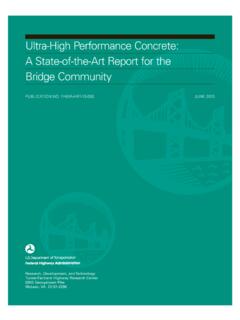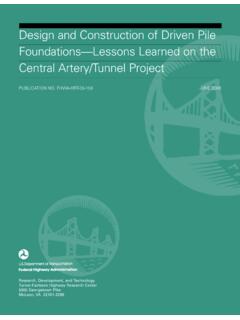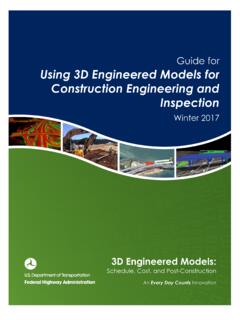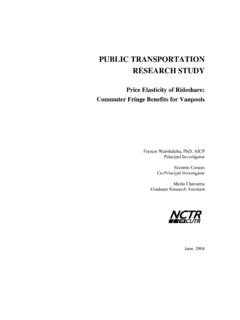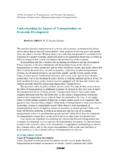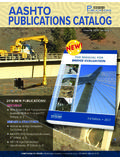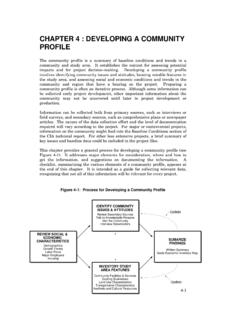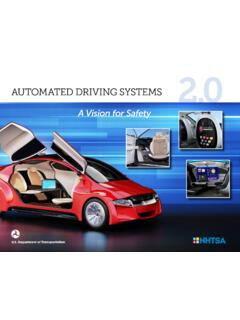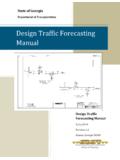Transcription of Chapter 14 The Importance of Public Transportation
1 The Importance of Public Transportation | | | | | 14-1 Chapter 14 The Importance of Public TransportationThe Role of Mass Transit ..14-2 Transit Performance Monitoring System (TPMS)..14-2 User Policy Benefits of ||||| Special TopicsThe Role of Mass TransitPublic Transportation provides people with mobility and access to employment, community resources, medicalcare, and recreational opportunities in communities across America. It benefits those who choose to ride, aswell as those who have no other choice: over 90 percent of Public assistance recipients do not own a car andmust rely on Public Transportation . Public transit provides a basic mobility service to these persons and to allothers without access to a incorporation of Public Transportation options and considerations into broader economic and land useplanning can also help a community expand business opportunities, reduce sprawl, and create a sense ofcommunity through transit-oriented development.
2 By creating a locus for Public activities, such developmentcontributes to a sense of community and can enhance neighborhood safety and security. For these reasons,areas with good Public transit systems are economically thriving communities and offer location advantages tobusinesses and individuals choosing to work or live in them. And in times of emergency, Public transportationis critical to safe and efficient evacuation, providing the resiliency American needs in its emergencytransportation Transportation also helps to reduce road congestion and travel times, air pollution, and energy and oilconsumption, all of which benefit both riders and non-riders Performance Monitoring System (TPMS)To analyze the characteristics and benefits of transit, the Federal Transit Administration conducted surveys oncar ownership, frequency of transit use, and transit trip purpose through the Transit Performance MonitoringSystem (TPMS).
3 These surveys were conducted between 1996 and 1998 to gain information on how transitdiffers across geographic regions and cities of varying sizes. These surveys, or case studies of individualtransit operators, were not designed to be statistically representative of national transit use or trends. Instead,what is presented here is an aggregation of the results of these case studies of 19 Public transit data collected have been analyzed on an aggregate basis as well as according to the subcategories ofsmall, medium, and large cities, and large suburban areas. Statistics are trip-based and reflect a choice onlyfor a particular trip. [See Exhibit 14-1].The Importance of Public Transportation | | | | | 14-3 User CharacteristicsCar Availability Many transit users do not have access to a car at the time they use percent of bus users, 49 percent of rail users, and 68 percent of all users surveyed did nothave access to a car at the time the trip was made.
4 The lower percentages for rail suggest that theexisting rail services capture a higher percentage of choice riders, , people with a car available at thetime the trip was made. [See Exhibit 14-2].Frequency of Use Mosttransit trips are made byriders who use transitfrequently. Slightly morethan 70 percent of all thetransit trips in the TPMS surveys were made bypassengers using transit 5 daysor more a week. Fortypercent of the trips surveyedwere made by passengersusing transit 5 days a week,14 percent by passengersusing transit 6 days a week, and 15 percent by passengers using transit 7 days a week. However, themajority of transit riders use transit infrequently. Almost 70 percent of the people who had usedtransit during the month had ridden on it 4 days or less per week. These infrequent riders, thoughnumerous, make less than 30 percent of all transit trips.
5 [See Exhibit 14-3].Duration of Use Passengers making thirty-five percent of the trips surveyed reported thatthey had been using transit for more than 4 years. This suggests that thirty percent of all transittrips provide a level of service that is better than or comparable to the automobile. However, most14-4 ||||| Special Topicstransit trips (65 percent) are by passengers who have been using transit for less than four years. Thirtypercent of all trips were by passengers who had been using transit for less than one year, and 10 percentby passengers using transit for less than a month. For these persons, transit may be serving as atemporary means of Transportation until they are able to purchase a car. Transit may also serve as atemporary means of Transportation to persons having their private vehicles repaired.
6 [See Exhibit 14-4].Transit Access Transit principally serves those within walking distance of a transit line. Themost frequently reported way of reaching transit was by walking, with about 70 percent of all thosesurveyed starting their transit trip in this way. Eighteen percent of those surveyed were continuing a tripthat had begun on a bus or train, 8 percent drove a car to access transit, and 3 percent were droppedoff. Transit use was less frequent and travel by car more frequent for passengers accessing transit fromhome compared to those that were accessing it away from home, although the differences were small.[See Exhibit 14-5].The Importance of Public Transportation | | | | | 14-5 Trip Purpose Work accounts for thelargest percentage of transit trips. Fiftypercent of all passengers surveyed were on theirway to or from work.
7 Transit also enablespeople to pursue educational opportunities;12 percent of all users surveyed were on theirway to or from college or other type of percent were traveling to obtain medicalservices, 13 percent to go shopping and 14percent were on their way to or from a socialevent or place of worship or attending to otherpersonal business. [See Exhibit 14-6].Work Trips Although transit provides aprincipal means of traveling to and from work inall urban areas, transit trips for workpurposes appear to account for a anincreasingly largerpercentage of total transittrips as the size of anurban area percent of all transitpassengers surveyed in largeurban areas were using transitfor work purposes comparedwith 48 percent in medium,and 41 percent in small urbanareas. In larger urban areas,transit is more likely to offerresidents with transitaccessibility a better level ofservice than an automobile during congested commuting time periods.
8 (Note that the 1995 NationwidePersonal Transportation Survey reported that thirty-five percent of all transit trips were for work and twopercent for work-related business.) [See Exhibit 14-7].Transit Trips to College orOther School Transit appearsto be a more important means oftraveling to and from college andschool in small and medium sizedurban areas and a less importantmeans in large urban areas.[See Exhibit 14-8]Fifteen percent of all userssurveyed in small urban areas percent of all users surveyedin medium urban areas were14-6 ||||| Special Topicstraveling to or from college or other schools compared with 8 percent in large urban areas. Passengerssurveyed in small urban areas made far more trips to other schools as opposed to college, while in medium-size and large urban areas trips were split more evenly between the Mode of Travel Users surveyedwere asked how they would have made their trip iftransit had not been available.
9 Eighteen percent ofthe passengers surveyed would have percent responded that they would havetaken a car, of which about half would have driventhemselves and half would have driven withsomeone else. These numbers indicate that transitmakes an important contribution to mitigating roadcongestion. The availability of transit wasparticularly crucial to the 21 percent whoreported that without transit they would nothave made the trip at all. This resultdemonstrates the Importance of transit in providingcertain segments of society with basic mobility.[See Exhibit 14-9].Gender and Age Women appear to use transiton a slightly more frequent basis than men. Fifty-five percent of the trips surveyed were by women and45 percent by men. Fifty-nine percent of all bus users and 52 percent of all rail users were women.
10 Transitalso appears to serve those with sufficient personal independence to travel on their own, although it should benoted that passengers under the age of 12 were not surveyed. More than 90 percent of trips were made bypassengers between the ages of 15 and 64. Sixty-six percent of the trips surveyed were made by passengersbetween the ages of 25 and 64, the period of life during which labor force participation rates are percent were by passengers between the ages of 15 and 24, most likely for work, school or socialpurposes. [See Exhibit 14-10].The Importance of Public Transportation | | | | | 14-7 Income Distribution The availability of Public Transportation is particularly important to peoplewith limited incomes. In 2000, the Bureau of the Census reported a poverty level income thresholdfor a family of four of $17,600, and for a family of one, $8,794.



